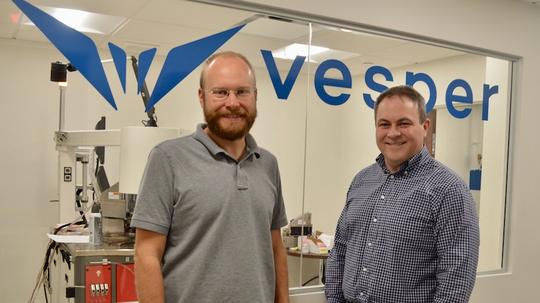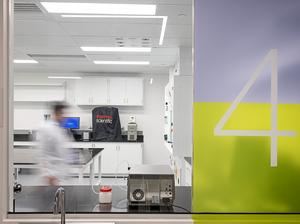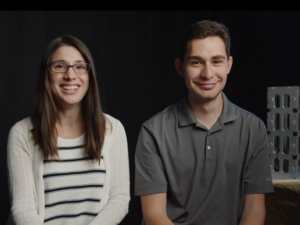
A sow lays on her side and, unknowingly, she begins to crush her piglets. But before the little pigs meet their demise, tiny microphones pick up their collective squeals and a patch on the mother pig alerts her, triggering her to stand up and save her piglets’ lives.
This life-saving contraption, created by a company called SwineTech, relies on the same kind of low-power, dirt- and water-resistant microphones that were found inside a few of the many voice-powered devices on the floor of this year’s Consumer Electronics Show in Las Vegas.
The company behind these tiny microphones is a Boston-based startup called Vesper, which thinks there's a larger wave of voice-activated devices to come. The market for such devices is already massive, with an estimated 39 million smart speaker owners in the United States alone, surpassing the adoption rates of both smartphones and tablets.
“It’s become this gigantic beast — this huge surge of people putting voice control into everything,” Matt Crowley, Vesper’s CEO, told me on a visit to the company’s Summer Street office in Downtown Crossing in December.
At 30 employees, Vesper, one of BostInno's startups to watch in 2018, has already gained the financial backing of Amazon, the world's most prominent purveyor of voice technology. With an ambition to stick its microphones everywhere, from remotes and appliances to wind turbines and car engines, the company could thrive in an age that is becoming dominated increasingly by voice-powered devices and, more broadly, systems that rely on sensors.

Vanquisher of dirt and high-power requirements
Vesper’s roots trace back to the University of Michigan, where Bobby Littrell and Karl Grosh made a breakthrough. The Ph.D. candidate and professor had received funding from NASA, the National Institutes of Health and the National Science Foundation to develop a new kind of microphone that could be more resilient than the capacitative microphones that are widely used in smartphones, laptops and other devices.
What made Littrell and Grosh’s microphone different was that it relied on piezoelectric crystals, which form a single layer of flaps that allow for dirt, water and oil to pass through without any build-up. Capacitative microphones, on the other hand, have a multi-membrane structure where things can get trapped in between layers and render the microphone useless.
Crowley said Vesper’s microphones have survived through significant stress tests. These tests include getting boiled in oil, submerged in the ocean and covered in dust. When the company was showing off its microphones at the Mobile World Congress in 2016, a customer took one and dropped it into a bottle of beer. The microphone survived.
"It doesn’t consume any power until you start talking to it."
The other significant difference is that piezoelectric can convert sound into electricity, allowing the microphone to power itself on whenever it picks up sound in a particular decibel range. This allows the microphone to consume almost zero energy in standby mode.
With its dirt-resistant and low-power qualities, Vesper’s microphones come with a couple of major benefits. The first is higher reliability, which is essential for devices that have a longer lifecycle. This is also important for devices that rely on multiple microphones, such as the Amazon Echo, to better track which direction a voice is coming from. Since Vesper’s microphones aren’t susceptible to water and dirt, it lowers their chance of failing, which helps maintain the overall health of a microphone array.
This also gives battery-powered devices a significant benefit. While giving batteries a longer lifecycle, the microphones also enable devices like TV remotes to listen to a voice command without the touch of a button because of its zero-power listening capabilities. So instead of holding down the button of your Apple TV or Roku remote to speak, you can bark a command while the remote sits a few feet away on the coffee table.
“It doesn’t consume any power until you start talking to it,” Crowley said.
The fact that Vesper uses piezoelectric crystals, which are a kind of crystal that can absorb electricity, isn’t entirely new. Littrell said piezoelectric microphones were used in hearing aids in the late 1960s and that they were later replaced by electret microphones in the next decade because they “had a wider frequency response and were less sensitive to vibrations.”
What separates their piezoelectric microphones from past designs is that they are built with the same manufacturing tools that are used to make integrated circuits, allowing for the creation of tiny structures and features. Littrell added that Vesper uses the same material that is used for filters in mobile phones.
“This material allows us to build smaller, lower noise piezoelectric microphones than were previously possible,” he said.
Voice-powered trash cans and beyond
While the company got its start last year by selling microphone components to electronics manufacturers in China, 2018 marks the company’s first big year its technology will appear in devices made by brand-name companies. For instance, at this year’s CES in Las Vegas, Vesper announced that its microphones would power LinkPlay’s do-it-yourself Amazon Alexa Voice kit for manufacturers who are interested in turning their products into voice-activated devices. Also on display at CES with Vesper microphones: the “Smart Egg Remote” from Remote Solution and a remote made by a large, unnamed TV manufacturer.
Crowley said there are other devices slated to debut this year with Vesper microphones, including voice-activated headsets, bathroom fixtures, trash cans and office furniture. Next year, Vesper will start making a push to get its microphones into smartphones.
While voice-activated trash cans and bathroom fixtures may sound frivolous on the surface, they could provide a new wave of accessibility options for people who have limited movement, for example. But for others, voice devices will be just another luxury.

Beyond voice-activated devices that are geared more toward consumers, Vesper is looking into more industrial applications. For instance, the company is working with two firms on gunshot detection technology. There is also potential to use Vesper’s microphones as sensors to monitor the health of various systems, including pipes, wind turbines and car engines. Crowley said the company has been in discussions with automotive companies about using Vesper’s microphones for predictive maintenance and road noise cancellation, among other things.
While consumers have begun embracing voice-activated devices like smart speakers, the idea of an exponentially growing number of microphones in every corner of the world has raised concern for privacy advocates. Crowley addressed this issue a few ways. For one, he said, Vesper’s microphones don’t record while in passive listening mode. He also noted that not every device using Vesper’s microphones will have an internet connection, such as the voice-controlled trash can. Ultimately, however, he said the issue of privacy will be up to the companies that use Vesper microphones to record and collect data.
“I certainly think the big companies have to make sure they’re responsible with user data,” Crowley said.
The challenges ahead
One of the challenges a company like Vesper faces as an early-stage hardware component supplier is dealing with incumbents that may have preferred relationships with brand-name manufacturers, said Scott Duke Kominers, a professor who studies entrepreneurship at Harvard Business School. How Vesper deals with that challenge depends on the cost structure of its microphones before reaching a real economy of scale.
“As you get there, you're going to be pushing against firms that have a lower willingness to pay while in the period when you are facing sort of the hardest part of your cost to serve,” he said.

Crowley said Vesper’s business model is set up to scale quickly since the company does not manufacture its own products and instead sources out production to GlobalFoundries, a semiconductor foundry that makes integrated circuits for large companies like AMD. The company’s Boston headquarters is mainly focused on research and development.
"If you look at how the company is evolving, there was a lot of thought put into that. It's like, 'let's start out with some 1-to-20 million unit-per-year kind of opportunities, then beyond that, we can look at the 50-to-100 million [unit] opportunities once we've got a little experience with our supply chain,'" Crowley said.
It also helps that Vesper has the backing of Amazon.
Vesper’s future with Amazon
One of the bigger questions for Vesper is how its relationship will evolve with Amazon. The connection between the two companies became known in December 2016 when Vesper announced that Amazon’s Alexa Fund contributed to the company's $15 million Series A round, which was led by Cambridge-based venture capital firm Accomplice, with participation from Hyperplane, another local firm.
At the time, Steve Rabuchin, Amazon Alexa’s vice president, said that the company sees Vesper as a way to help Amazon create new Alexa experiences. “We see the potential for Vesper’s technology to unlock compelling new use cases for Alexa, such as portable electronics where dirt and moisture resistance is an important attribute for microphones,” he said in a statement.
"They partner with people like us because they want to make it extremely easy for people to implement voice in all kinds of products."
That idea has begun to materialize with third-party devices like LinkPlay’s Amazon Alexa Voice kit that was displayed at CES and a partnership with Synaptics, which is using Vesper’s microphones to make “ultra-durable” Alexa devices.
“They partner with people like us because they want to make it extremely easy for people to implement voice in all kinds of products," Crowley said.
But whether Amazon will start using Vesper’s microphones for its own devices, like the Echo, remains an open question. An Amazon spokeswoman declined to comment on the matter, saying that the company “can’t speculate on the future roadmap.”
When I asked Crowley about whether Amazon uses Vesper’s microphones, he gave what seemed like an optimistic answer for the company's future.
“Not right now,” he said.
Editor's note: Added a mention of Accomplice and Hyperplane's involvement in the Series A.








